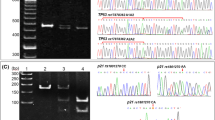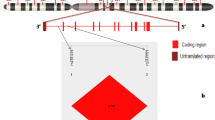Abstract
Tumour suppressor protein 53 (p53) plays a central role in apoptosis, cell proliferation and death. Previously studies found contribution of functional p53 Arg72Pro polymorphism (TP53 rs1042522G/C polymorphism) in the development of systemic lupus erythematosus (SLE) remains controversial. In this study, for the first time, we evaluated its association with SLE in a Chinese Han population. This case–control study enrolled 1470 SLE patients and 2283 healthy controls. The genotyping of TP53 rs1042522 polymorphism was determined by Sequenom Mass ARRAY technology. Statistical analysis was conducted by Chi-square test (χ 2 test). Odds ratio (OR) with 95% confidence interval (CI) was calculated using unconditional logistic regression with adjusting age and sex. Allele and genotype frequencies of TP53 rs1042522G/C polymorphism showed statistically significant difference between the SLE patients and the normal controls (C vs. G: OR = 0.89, 95% CI 0.89–0.97, p = 0.01; (GC + CC) vs. GG using recessive model: OR = 0.84, 95% CI 0.73–0.96, p = 0.01; GC vs. GG using co-dominant model: OR = 0.86, 95% CI 0.74–0.99, p = 0.04; CC vs. GG using co-dominant model: OR = 0.80, 95% CI 0.66–0.96, p = 0.02; GC vs. GG using co-dominant model: OR = 0.86, 95% CI 0.74–0.99, p = 0.02). In addition, there was weak association between discoid rash and distribution of TP53 rs1042522G/C polymorphism in SLE patients (C vs. G: OR = 1.25, 95% CI 1.00–1.55, p = 0.04; CC vs. GG using co-dominant model: OR = 1.54, 95% CI 1.10–2.36, p = 0.04). Our finding suggests a significant relationship between the TP53 rs1042522G/C polymorphism and SLE. TP53 rs1042522G/C polymorphism would be promising as an indicator of SLE as well as the therapeutic target if its functions and mechanisms could be further investigated.

Similar content being viewed by others
References
Watanabe N, Takabayashi K (2009) Recent investigations on the basis of pathogenesis of SLE and new therapeutic approaches. Nippon Rinsho 67(3):500–505
Wong M, Tsao BP (2006) Current topics in human SLE genetics. Springer Semin Immunopathol 28(2):97–107
Lorenz HM, Herrmann M, Winkler T, Gaipl U, Kalden JR (2000) Role of apoptosis in autoimmunity. Apoptosis 5:443–449
Gaipl US, Munoz LE, Grossmayer G et al (2007) Clearance deficiency and systemic lupus erythematosus (SLE). J Autoimmun 28:114–121
Vogelstein B, Lane D, Levine AJ (2000) Surfing the p53 network. Nature 408:307–310
Takatori H, Kawashima H, Suzuki K, Nakajima H (2014) Role of p53 in systemic autoimmune diseases. Crit Rev Immunol 34(6):509–516
Nath SK, Kelly JA, Namjou B et al (2001) Evidence for a susceptibility gene, SLEV1, on chromosome 17p13 in families with vitiligo-related systemic lupus erythematosus. Am J Hum Genet 69:1401–1406
Johansson CM, Zunec R, Garcia MA et al (2004) Chromosome 17p12-q11 harbors susceptibility loci for systemic lupus erythematosus. Hum Genet 115:230–238
Kovacs B, Patel A, Hershey JN, Dennis GJ, Kirschfink M, Tsokos GC (1997) Antibodies against p53 in sera from patients with systemic lupus erythematosus and other rheumatic diseases. Arthritis Rheum 40:980–982
Miret C, Molina R, Filella X et al (2003) Relationship of p53 with other oncogenes, cytokines and systemic lupus erythematosus activity. Tumour Bio 24:185–188
Sullivan A, Lu X (2007) ASPP: a new family of oncogenes and tumour suppressor genes. Br J Cancer 96(2):196–200
Lee YH, Rho YH, Choi SJ et al (2005) The functional p53 codon 72 polymorphism is associated with systemic lupus erythematosus. Lupus 14:842–845
Onel KB, Huo D, Hastings D, Fryer-Biggs J, Crow MK, Onel K (2009) Lack of association of the TP53 Arg72Pro SNP and the MDM2 SNP309 with systemic lupus erythematosus in Caucasian, African American, and Asian children and adults. Lupus 18(1):61–66
Sanchez E, Sabio JM, Callejas JL et al (2006) Study of a functional polymorphism in the p53 gene in systemic lupus erythematosus: lack of replication in a Spanish population. Lupus 15:658–661
Piotrowski P, Lianeri M, Mostowska M, Wudarski M, Chwalinska-Sadowska H, Jagodzinski PP (2008) Contribution of polymorphism in codon 72 of p53 gene to systemic lupus erythematosus in Poland. Lupus 17(2):148–151
Hochberg MC (1997) Updating the American College of Rheumatology revised criteria for the classification of systemic lupus erythematosus. Arthritis Rheum 40(9):1725
Shi YY, He L (2005) SHEsis, a powerful software platform for analyses of linkage disequilibrium, haplotype construction, and genetic association at polymorphism loci. Cell Res 15(2):97–98
Li Z, Zhang Z, He Z, Tang W, Li T, Zeng Z, He L et al (2009) A partition-ligation-combination-subdivision EM algorithm for haplotype inference with multiallelic markers: update of the SHEsis. Cell Res 19(4):519–523
Beckman, G., Birgander, R., Sjalander, A., Saha, N., Holmberg, P.A., Kivela, A., et al (1994) Is p53 polymorphism maintained by natural selection? Hum Hered 44(5):266–270
Sjalander, A., Birgander, R., Saha, N., Beckman, L., Beckman, G (1996) p53 polymorphisms and haplotypes show distinct differences between major ethnic groups. Hum Hered. 46(1):41–48.
Bijl M, Limburg PC, Kallenberg CG (2001) New insights into the pathogenesis of systemic lupus erythematosus (SLE): the role of apoptosis. Neth J Med 59(2):66–75
El-Sayed ZA, Farag DH, Eissa S (2003) Tumor suppressor protein p53 and anti-p53 autoantibodies in pediatric rheumatological diseases. Pediatr Allergy Immunol 14:229–233
Sakamuro D, Sabbatini P, White E, Prendergast GC (1997) The polyproline region of p53 is required to activate apoptosis but not growth arrest. Oncogene 15:887–898
Chauhan R, Handa R, Das TP, Pati U (2004) Over-expression of TATA binding protein (TBP) and p53 and autoantibodies to these antigens are features of systemic sclerosis, systemic lupus erythematosus and overlap syndromes. Clin Exp Immunol 136:574–584
Dumont P, Leu JI, Della Pietra AC, George DL et al (2003) The codon 72 polymorphic variants of p53 have markedly different apoptotic potential. Nat Genet 33(3):357–365
Matlashewski GJ, Tuck S, Pim D et al (1987) Primary structure polymorphism at amino acid residue 72 of human p53. Mol Cell Biol 7:961–963
Pim D, Banks L (2004) p53 polymorphic variants at codon 72 exert different effects on cell cycle progression. Int J Cancer 108:196–199
Zeng FQ, Yin RF, Tan GZ, Guo Q, Xu DQ (2004) Characterization of DNA antigens from immune complexes deposited in the skin of patients with systemic lupus erythematosus. Chin Med J (Engl) 117(7):1066–1071
Gabrielli A, Corvetta A, Montroni M, Rupoli S, Danieli G (1985 Sep) Immune deposits in normal skin of patients with systemic lupus erythematosus: relationship to the serum capacity to solubilize immune complexes. Clin Immunol Immunopathol 36(3):266–274
Acknowledgements
This work was financed by the Natural Science Foundation of Anhui Province (1608085QH194), Natural Scientific Research Foundation of Anhui University of Traditional Chinese Medicine (2015 ZR002) and Doctoral Scientific Research Foundation of Anhui University of Traditional Chinese Medicine (2014RC001).
Author information
Authors and Affiliations
Corresponding author
Ethics declarations
Conflict of interest
The authors declare that they have no conflict of interest.
Ethical approval
All procedures performed in studies involving human participants were in accordance with the ethical standards of the institutional and/or national research committee and with the 1964 Helsinki Declaration and its later amendments or comparable ethical standards. This article does not contain any studies with animals performed by any of the authors.
Informed consent
Informed consent was obtained from all individual participants included in the study.
Rights and permissions
About this article
Cite this article
Yang, J., Zhu, Jm., Wu, S. et al. Association study between the TP53 Rs1042522G/C polymorphism and susceptibility to systemic lupus erythematosus in a Chinese Han population. Rheumatol Int 37, 523–529 (2017). https://doi.org/10.1007/s00296-017-3662-0
Received:
Accepted:
Published:
Issue Date:
DOI: https://doi.org/10.1007/s00296-017-3662-0




